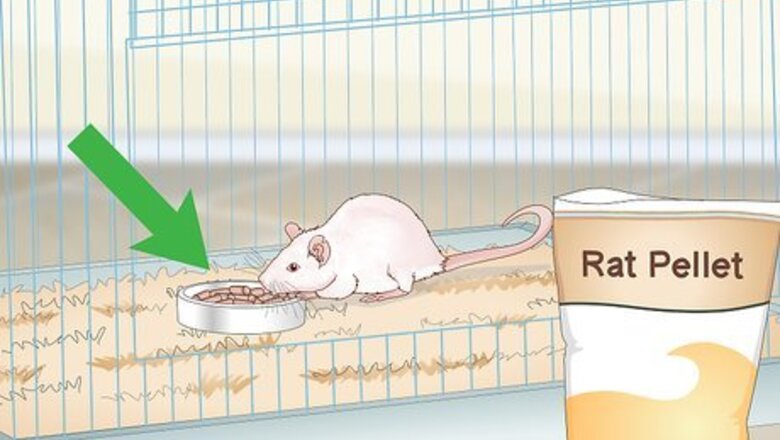
views
X
Research source
They need to stay with their mother, who will nurse and care for them, for 4-5 weeks.[2]
X
Research source
After weaning, they require good nutrition, socialization, proper housing, hygiene, training, and exercise to get a healthy start that will benefit them throughout their lives. Like any pet, your young rat will thrive if you learn how to provide what it needs.
Feeding Baby Rats
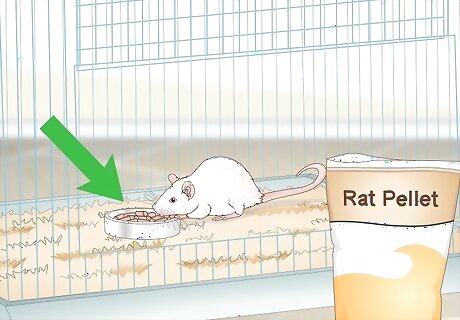
Provide a well-balanced pellet food once the rat is 2 weeks old. All rats over 2 weeks of age need a diet that is relatively low in fiber, high in protein, and contains a low percentage of fat. For the first 2 weeks of life, baby rats get all their nutrition from their mother’s milk. To achieve the right balance of nutrients, make sure you offer store-bought pellet food that is specially formulated for rats. This will ensure that your rat is getting all the nutrients and calories it needs to survive. Rat food is often called “rodent block,” as it comes in hard, block-shaped pieces. Buy rat food in some grocery stores, in pet stores, or online.
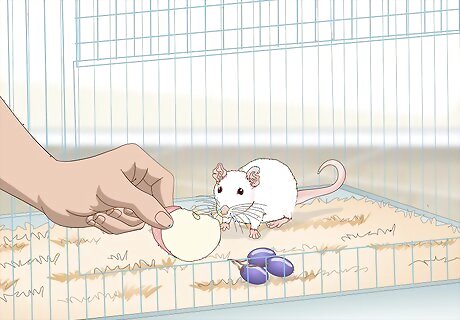
Offer a variety of healthy vegetarian supplements. Young pet rats will benefit from having a range of options to nibble. Small amounts of things like fresh vegetables, fruits, nuts and seeds, whole grain cereals, and even crackers will supplement your rat’s diet. Just like humans, rats have individual tastes and some can be picky eaters. Introduce a wide variety of choices until you can determine which ones your rat prefers. Rats can eat meat, but it is not necessary for their overall health and it should not be a staple in your rat’s diet. There are many foods that rats cannot eat, including apple seeds, oranges, and peanuts. Before introducing your rat to a new food, check online to make sure it is not dangerous to rats. Some safe foods to offer your rat include apples, blueberries, grapes, and dried cereal.

Feed your rat twice a day. Refresh your rat’s food and water twice a day. Your rat may not eat all of its food in one sitting and will likely nibble on things throughout the day and night. Try to adjust the amount of food you give your rat so that there is no uneaten food left in its bowl by the next feeding.
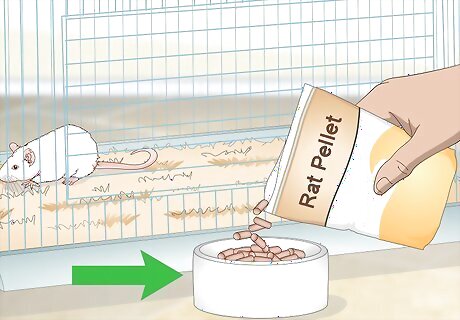
Keep food in clean ceramic dishes. Ceramic dishes are easy to clean, resist tipping, and minimize noise while the rat eats. Choose bowls that will fit easily in your rats cage and that are not too high for them to easily access their food. It’s a good idea to clean the bowls with soap and water at least once a day.
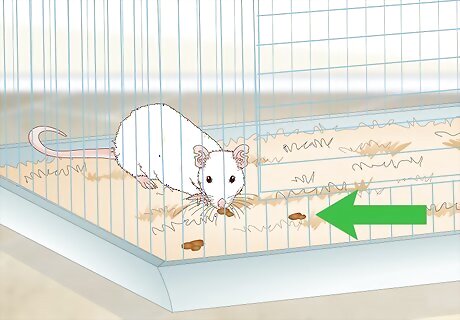
Let your rat eat its droppings. This may be an unappetizing habit to watch, but rats are actually supposed to eat their feces. It’s a process called coprophagy and it allows your rat to optimize its absorption of nutrients from its food. Without this process of ingesting its food twice, rats would be unable to benefit from all the nutrients in their diet.

Hide food to encourage foraging. Rats evolved to spend most of their day looking for food. As pets, all their basic needs are met by people, which can actually be quite boring for a young rat. In order to activate your rat’s foraging instinct, try to hide their food throughout their environment. You can purchase foraging toys online or at a pet store that are specifically designed to make it challenging for your rat to access its food.
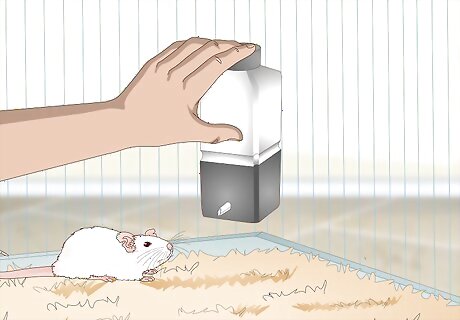
Give your rat fresh water. Purchase a rodent water bottle that you can attach to the rat’s enclosure. Change its water daily and scrub the bottle weekly. It’s a good idea to provide distilled or filtered water for your rat. If your rat is outside of its enclosure, make sure it still has access to water by placing a small dish of water somewhere that is easily within its reach.
Socializing Your Young Rat
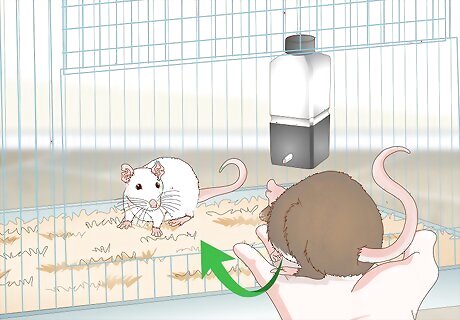
Get your rat a companion of the same sex. Rats are very social creatures and should not be raised alone. To avoid breeding, make sure you get a companion rat of the same sex. They need to grow up around other rats, preferably of the same age, in order to be happy and well-socialized. Rats become capable of reproducing by 5 weeks of age, so it’s important to learn their sex and keep males from females before they reach this age. To determine your rat’s sex, hold it gently so its underside is visible. Male rats as young as 3 weeks of age have a large and noticeable scrotum, which should help you distinguish them from the females.
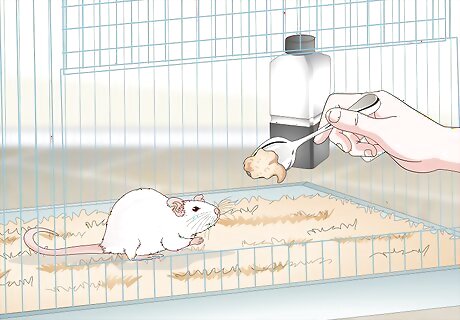
Trust train your rat. Your young rat will need to learn to trust you and bond with you in order to be a good pet. You can do this with patience, a spoon and a soft treat, like peanut butter, to use as a lure and a reward. Offer your rat a small amount of the treat where it is most comfortable, usually inside its cage. The second time you offer the treat, hold the spoon by the door of the cage. The third time, require the rat to walk onto your body to get the treat. Continue to work with the rat a few minutes each day until it allows you to pick it up and hold it to deliver the treat.
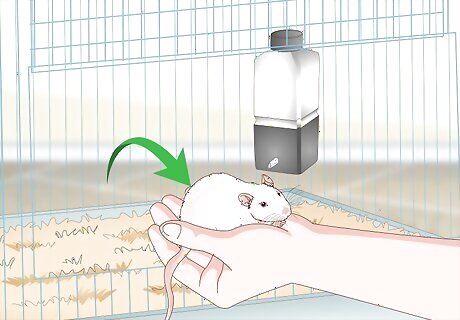
Hold your rat gently. Form a scoop with both hands to gently lift the rat. Alternatively, grasp the rat around its upper back and chest while keeping its legs and neck free and supporting its back end with your other hand. Rats will also often just climb onto you if you hold out your hand, arm, or leg, and may enjoy hanging out freely on your shoulder. A calm and well-socialized rat will enjoy freely moving about in your hands, along your arms, and up onto your shoulders. Never hold a rat by its tail, as this could cause pain and even serious injury.
Providing Proper Housing

Buy a proper cage online or at a pet store. The minimum amount of space that a single rat needs is 2.5 cubic feet (0.07 cubic meters). You should look for a cage that is made of wire that has ⁄2 in (1.3 cm) openings between the bars. Be wary of cages marketed exclusively for rats, as these can often be too small or of poor quality. Shop for a cage based on its size and wire gauging. A cage that provides height, as well as width and depth, will allow your rat plenty of vertical space for climbing and playing.
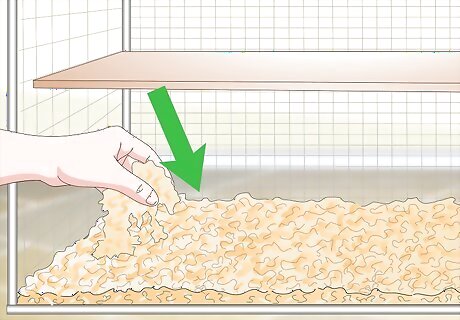
Line the bottom of the cage with litter to catch waste. Visit your local pet store or look online for a rat-friendly product that is not dusty or toxic. Line the cage with .25 inches (0.64 cm) of litter. Good options for litter include newspaper pellets, aspen chips, or wheat litter. Avoid cedar bedding, clay litter, and aromatic pine shavings as these can irritate your rat’s respiratory system.

Set up tunnels for your rat. Purchase rodent tunnels at the pet store or online. Use a piece of PVC pipe or a block of wood with a hole drilled in it for a DIY tunnel. Line the inside of the tube with bedding material to provide an additional cozy spot where it can sleep. Rats are naturally curious and will enjoy exploring new tunnels.

Create space for your rats to run. Rats are naturally inclined to spend a lot of their day running. To support this healthy behavior, purchase an exercise wheel that is at least 11 inches (28 cm) in diameter. Be wary of wire wheels, as these can trap and injure your rat. Exercise balls are another way you can encourage your rat to run around. They have the added benefit of letting your rat explore beyond its cage.

Give your rat room to climb. Climbing is an important activity for rats, especially when confined in a cage. Outfit your baby rat’s cage with things it can climb, like ropes, small ladders, branches, or stacked cardboard boxes. Avoid wire ramps that can trap and injure your rat. Rats also enjoy climbing up the sides of their cage.

Provide things for your rat to safely chew on. Chewing is an important part of a rat’s daily activities and ensures they maintain healthy teeth. Purchase chew toys specifically for rodents from a pet store or online. Offer inexpensive things for your rat to chew on and shred, like cardboard boxes, the inner tube of a toilet paper or paper towel roll, or egg cartons. A rat’s teeth grow continuously and must be worn down by lots and lots of chewing to avoid problems like misalignments of the jaw or injuries.
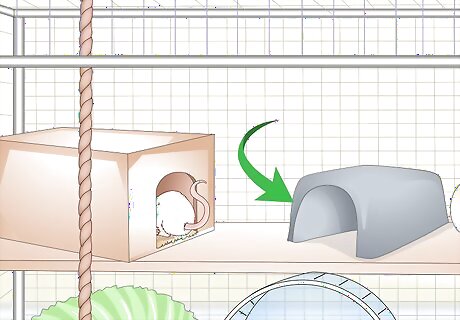
Give your rat multiple sleeping options. Provide a nesting area as well as an elevated bed for your rat to satisfy both its need to burrow and hide and its love of climbing. Purchase a hard plastic box or dome for this purpose, or you can use a small cardboard box. Fill the nesting bed with soft, shreddable bedding made from clean straw, strips of newspaper, cotton balls, or felt strips. Rats love hammocks. Rodent hammocks can be purchased or made using soft pieces of cloth strung across the corner of a cage.
Keeping Your Rat Healthy
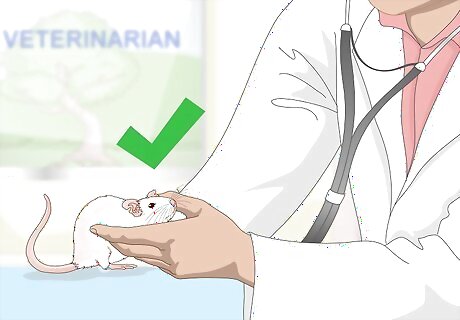
Take your rat for veterinary check-ups. It’s important to take your young rat for a veterinary check-up early. This will help acclimate the rat to vet visits, but it will also help identify any potential health problems early. Because rats only live for 2 to 3 years, have your rat vet-checked every 6 months.
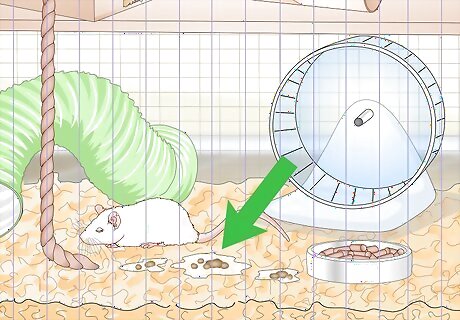
Watch for signs of illness. Rats are susceptible to diseases like any creature, so it’s important to monitor their behavior for signs of illness. The following may be signs that your rat needs to go to the vet: Diminished appetite or increased thirst. Diarrhea or constipation. Sleeping more than usual. Sneezing. Puffed-up fur. Red secretion around the rat’s eyes and nostrils. Skin irritations, including lumps, bumps, or excessive scratching.

Maintain a clean environment. Clean your rat’s cage on a regular schedule by changing out litter and soiled bedding. Wipe down the inside of the cage with vinegar and do the same with plastic toys, tunnels, and beds. Change out cardboard toys and boxes whenever they become soiled. Spot-clean the cage daily and remove any wet or soiled bedding. Clean your rat’s cage before it begins to smell like ammonia from waste build-up. This could mean changing it as frequently as every 4 days for young rats who have high metabolisms because they are growing. Avoid using toxic cleaners like bleach, as these can make your rat ill. Wash hammocks and other fabric with non-toxic laundry detergent.
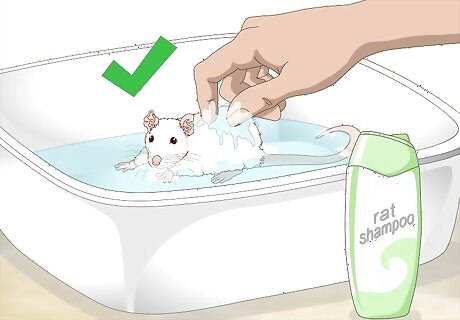
Bathe your rat. Fill a small basin or a bathroom sink with 1–2 in (2.5–5.1 cm) of water so that the rat can comfortably stand without submerging its face. Wash the rat with tear-free shampoo or a shampoo marketed specifically for rodents, avoiding its face and eyes. Rinse the rat thoroughly, then gently dry it with a towel. Rats groom themselves, but they can still get dirty, and they sometimes have an odor. Don’t bathe your rat more than once a month or you’ll deplete the natural oils in its skin. Use bath time as a time to make sure your rat looks healthy and is free from injury. Check for wounds, lumps, and fleas or ticks as you bathe it. Follow-up on any concerning issues with a visit to your vet. When you bathe your rat for the first time, try to do it when the weather is warm so it doesn't get too cold. Use warm water, but not hotter than 100 °F (38 °C). Like any new situation, ease your rat into it using a calm and gentle voice and treats as a lure and reward.



















Comments
0 comment